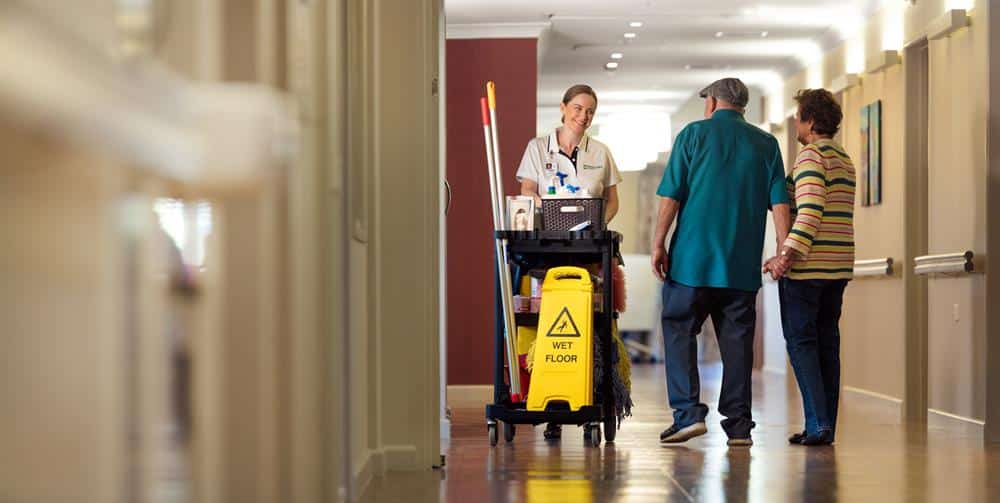
Residential aged care funding explained
Although residential aged care fees vary, Feros Care can help you understand the costs and funding options available.
Ahhhhh! That’s the sound of a sigh of relief – which is something we often hear from seniors who have finally made the move into a Residential Village. Suddenly the pressure is lifted, the finances are sorted, the care services are on tap and you can just relax knowing your future is secured.
Before that blissful state however, there’s a bit to be organised. If your next step on the aged care journey is into a residential village your need to do your homework first. The good news is that the future is looking bright, with government support available through My Aged Care (MAC) to help you access care on either a temporary (respite) or long term (residential) basis.
Residential Aged Care fees – deconstructed!
Nothing says ‘complicated’ quite like government aged care funding. But thanks to the specialists at Feros Care, the rest of us can get the inside scoop on what it all means – without tearing our hair out.
Firstly, you’ll need an ACAT assessment, if you haven’t already had one, to be approved for residential care. It can be organised by your GP, MAC or Feros Care can help you arrange one. Tick!
What are the different types of fees?
Next, the Services Australia carries out both income and asset assessments for residential aged care and what you pay depends on your needs and your financial situation. Ok, seems fair enough. Once you know where you stand, there are various ways you can choose to pay your fees. This is worked out in consultation with the aged care provider managing the residential village you’re considering. Essentially, fees are broken into two areas, care fees and accommodation fees.
Daily Care Fees
All residents pay a Basic Daily Care Fee towards the cost of expenses like meals, cleaning, power, laundry and nursing or personal care. This is all of the day-to-day stuff which is done for you – so get ready to hang up your rubber gloves! This fee is set by the government and is 85% of the single person rate of the basic age pension.
Means-Tested Care Fees
In addition, some people are required to pay a Means-Tested Care Fee towards the cost of their care based on their income and assets assessment. The means-tested care fee is an ongoing fee that you pay towards the cost of your personal and clinical care, such as bathing, dressing, grooming, going to the toilet, specialised nursing services, medication assistance, or catheter care.This fee will range between $0 – $252.20, depending on your financial situation.
Accommodation Fees
Some people have the cost of their accommodation met in full, or part, by the government, while others with sufficient finances will be asked to pay the price agreed with the aged care provider. The amount you pay for will be based on your income and assets assessment, and will be one of the following:
No accommodation costs: If your income and assets are below a certain amount, the government will pay your accommodation costs.
An accommodation contribution: You are required to pay part of the cost of your accommodation, and the government will pay the rest.
An accommodation payment: You are required to pay the full cost of your accommodation.
You can choose to pay your accommodation costs by:
A lump-sum style ‘refundable accommodation contribution’ (RAC)
If you’re cashed up, you can pay the full RAC amount of say $300,000 for example in a lump sum upfront. Any unused money is fully refundable if you leave the home. The amount of RAC charged depends on the room you choose and is determined by the aged care village. It also will reflect the demographics of the neighbourhood – so expect to pay more in chi-chi suburbs! Some offer all the ‘bells and whistles’, while others are more modest.
A rental-type payment called a ‘daily accommodation contribution’ (DAC)
A DAC can be paid instead of a RAC payment. However, most residential villages will require as least a small percentage of the RAC to be paid as a deposit to secure your room.
A combination of both RAD and DAP
You can also pay a part RAC amount, of say $100,000 upfront, and then the remaining amount as a reduced daily accommodation payment (DAC).If you choose a higher standard of accommodation or extra services such as different meals, free Wi-Fi or exercise programs for example, you may also have to pay extra. The same applies if you require additional services that are above your assessed care needs or above what your provider is required to provide.
Respite or permanent residential care
If your decision to enter residential care isn’t final or you need some more “convincing”, then respite care might be the answer. Some aged care homes will offer you the chance to enter on respite care funding for a short period of time. This is a great opportunity to see how well you fit in at the residential facility, and if you like other residents, the activities on offer, or the facility itself. You need to go through the same assesment to be approved for respite care funding. Feel free to call Feros Care’s advisors on 1300 090 256 and we will get you started on the journey.
Residential care first steps
All in all, residential aged care is often overcomplicated – leaving punters with many, many questions. That’s where Feros Care can help, starting with our Frequently Asked Questions which might give you some answers. Better still, we have friendly and experienced consultants to help you do the maths! And we guarantee that a chat with Feros Care about your options will help you feel more confident in making plans for your future. Call us on 1300 090 256, and we can help you get started.